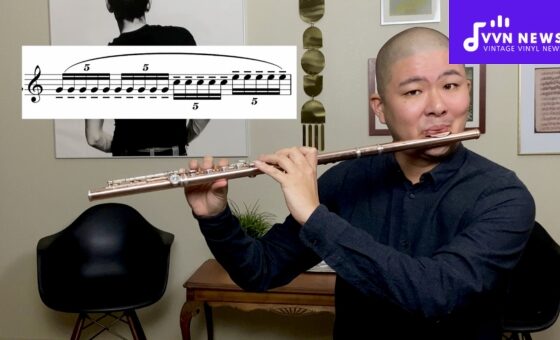Flute playing is a beautiful art that requires precision, practice, and skill. One of the most crucial aspects of mastering the flute is achieving perfect intonation.
When playing the flute, intonation refers to the accuracy of pitch and tone produced by each note. Without proper intonation, even the most skilled flutist can sound off-key or out of tune.
In this article, I will share some valuable tips and techniques to help you achieve flawless flute intonation.
Whether you’re a beginner or an intermediate player looking to refine your skills, these strategies will greatly improve your overall flute-playing experience.
Now let’s take a closer look at what flute intonation entails and why it matters. Intonation is the ability to play each note at the correct pitch with accurate tone quality.
It involves using breath control, finger placement on the keys, and embouchure formation to produce harmonically balanced sounds.
Flute players must have a strong grasp of intonation because it affects their ability to blend with other musicians in an ensemble or orchestra setting.
Good intonation allows for seamless transitions between notes within a piece, creating a pleasant and cohesive musical experience for both performers and listeners alike.
What is the relationship between tone and intonation in flute playing?
The relationship between tone and intonation in flute playing is crucial for producing beautiful and harmonious music.
While tone refers to the quality and clarity of sound produced by the instrument, intonation focuses on the accuracy of pitch.
When these two elements work together seamlessly, a flutist can achieve a balanced and pleasing performance.
The tone is influenced by factors such as embouchure formation, air support, and finger placement on the keys.
A proper embouchure involves forming a small, circular shape with your lips while directing your breath toward the blowing edge of the mouthpiece. This technique allows for a clear and resonant tone production.
Intonation, on the other hand, is influenced by how well you control your breath support, finger placement on the keys, and even your posture.
Improper finger placement or inconsistencies in breath support can lead to notes being played out of tune.
Maintaining good posture while playing the flute is also vital for achieving perfect intonation. Your back should be straight but relaxed, while your head should be held high without tension in your neck or shoulders.
This alignment allows for better airflow through the instrument, resulting in improved intonation.
To achieve ideal intonation, it is essential to train your ears to recognize pitch discrepancies. Regularly practicing with a tuner can help you identify any notes that are consistently sharp or flat.
By comparing your pitch to that of a reference note, you can make small adjustments using techniques such as lip placement or alternative fingerings.
Another factor that influences flute intonation is the head joint cork position. The position of this cork affects how far into the flute air travels before reaching the embouchure hole.
Adjusting this cork can fine-tune specific notes or correct overall pitch tendencies.
Tone and intonation are closely intertwined in flute playing. The quality of your sound depends on both factors working together harmoniously.
By focusing on proper embouchure formation, breath support, finger placement, posture, and regular tuning practice, you can achieve perfect intonation and produce beautiful music on the flute.
Also Read: Christmas Flute Books [Best Picks For Festive Melodies]
How does Posture Affect Flute Intonation?

Proper posture is crucial for achieving perfect flute intonation. Playing the flute requires a balanced and relaxed body position that allows for free airflow and optimal breath control.
When the body is properly aligned, it positively impacts the pitch and tone produced by the instrument.
- Maintain a Straight Spine: Sit or stand with your back straight, aligning your head, neck, and spine in a natural position. This alignment creates a clear path for the air to flow through the instrument.
- Relax the Shoulders: Avoid tensing your shoulders as it can restrict airflow and impede proper fingering technique. Keep your shoulders relaxed and rolled down to establish a stable foundation for playing.
- Support with Proper Breathing Technique: Utilize diaphragmatic breathing, where you expand your lower abdomen while inhaling deeply. This allows for a continuous flow of air without unnecessary tension, resulting in better control over pitch accuracy.
- Align the Flute Correctly: Hold the flute parallel to the ground, with the head joint angled towards your mouth at approximately 45 degrees. Ensure that your embouchure (the way you position your lips on the mouthpiece) is centered on the embouchure hole to promote evenness of tone across all registers.
- Check Body Tension: Regularly assess your body for any tension buildup while playing. Consciously release tension in areas such as the arms, hands, jaw, and neck to maintain the fluidity of movement and a relaxed playing experience.
By maintaining proper posture and body alignment when playing the flute, you create an optimal foundation for producing accurate intonation.
Practice mindful awareness of your body position throughout each repertoire or practice session to develop good habits that will enhance both your sound and intonation.
Also Read: 11 Best Beginner Flute Books [Start Your Melodic Journey Right]
What is intonation in flute music?
Intonation in flute music refers to the accuracy of pitch and tone produced by each note. It is the ability to play each note at the correct pitch with accurate tone quality.
Good intonation allows for seamless transitions between notes within a piece, creating a pleasant and cohesive musical experience.
Flute players achieve intonation by using breath control, finger placement on the keys, and embouchure formation.
They must develop a keen ear to recognize and adjust their playing to ensure that each note is in tune.
Intonation plays an essential role in ensemble or orchestra settings as it determines how well a flutist can blend with other musicians.
It allows for harmonically balanced sounds and creates a cohesive musical experience for performers and listeners alike.
To achieve proper intonation, flute players must prioritize their posture, embouchure formation, breath control, finger placement, and ear training.
By focusing on these aspects of playing, flutists can attain flawless intonation that will enhance their overall flute-playing experience.
Where does the process of tuning the flute begin?

Tuning the flute is a crucial step in achieving perfect intonation. It ensures that each note played on the instrument is in tune with the desired pitch.
The tuning process typically begins with the head joint cork, which is responsible for adjusting the overall length of the flute.
The head joint cork can be moved either in or out to change the pitch of the instrument. To begin, follow these steps:
- Inspect and adjust the cork: Start by checking if there is any debris or damage on the cork. Ensure that it fits snugly into the tenon and is not too loose or tight. Use a cork grease to lubricate if necessary.
- Find a reference pitch: Using a reliable tuner or a pitch reference source, find a reference pitch such as A440 Hz, which is commonly used as a standard for tuning.
- Play an “A” note: With all keys closed, blow into the flute to produce an “A.” Compare this note with your tuner or pitch reference and note if it is sharp (higher) or flat (lower) about A440 Hz.
- Adjusting the head joint cork: If your “A” note is sharp, you will need to move the cork further out from the barrel of the flute, effectively lengthening it. Conversely, if it’s flat, push it inwards to shorten its length.
- Repeat and refine: After adjusting, play another “A” and compare it again with your reference pitch. Fine-tune as needed until you achieve perfect intonation.
Remember that each flute differs slightly in its individual intonation tendencies due to variations in manufacturing and design factors.
Hence, regular attention and adjustment to your instrument are essential for maintaining consistent intonation performance.
Also Read: How To Clean Your Flute [Keep Your Instrument Shiny & Sounding Great]
How do you effectively tune a flute?
Tuning the flute is an essential step in achieving perfect intonation. Properly tuning your instrument will ensure that each note is played at the correct pitch. Here are some steps to effectively tune your flute:
- Start with a well-maintained instrument: Before tuning, make sure your flute is in excellent working condition. Clean the instrument thoroughly, oil the keys if necessary, and ensure that the pads are sealing properly.
- Warm up your flute: Play a few long tones to warm up your flute before starting the tuning process. This will help stabilize the pitch.
- Adjust the head joint position: Begin by adjusting the position of the head joint in relation to the body of the flute. The crown or cork at the end of the head joint can be adjusted to lengthen or shorten it, which affects the overall pitch. Experiment with small adjustments until you achieve optimal pitch.
- Check against a tuner: Play a note in your comfortable playing range and check its pitch against an electronic tuner. The tuner will display whether you are playing sharp (too high) or flat (too low). Adjust as necessary by slightly moving the head joint position.
- Use harmonics for additional tuning: Flutists often use harmonics to fine-tune their instruments. Harmonics are achieved by blowing with different levels of airspeed and pressure while fingering specific notes on the flute’s keys.
- Listen for resonance: Beyond relying solely on visual cues from a tuner, listening for resonance is crucial for accurate tuning. Pay attention to how each note sounds and adjust accordingly for optimal tonal quality.
By following these steps, you can effectively tune your flute and achieve better intonation overall. Remember that consistent practice and development of good ear training skills will also contribute towards mastering intonation on the flute over time.
Once you have successfully tuned your flute, you may still encounter situations where individual notes need adjustment to achieve perfect intonation. Here are some techniques to help you make those fine-tuning adjustments:
- Use your ears: The first step is to develop a keen sense of hearing and train your ears to recognize when a note is slightly out of tune. This awareness will come with practice and experience.
- Experiment with embouchure: Slight adjustments in embouchure formation can sometimes help bring a note into tune. Experiment with different lip positions, angles, and levels of breath support to find the sweet spot for each note.
- Check finger placement: Pay attention to how your fingers are positioned on the keys. Even small adjustments in finger placement can impact intonation. Practice playing each note slowly while observing your finger technique.
- Make slight adjustments in pitch: Use your lips and air stream to slightly manipulate the pitch of a note if necessary. For example, if a note sounds flat, increase the speed of your air stream or slightly raise the pitch by adjusting the embouchure pressure.
- Practice long tones: Long tones are an excellent exercise for working on intonation. Play sustained notes and focus on keeping them in tune throughout their duration.
- Work with a tuner or app: Use a tuner or smartphone app designed for tuning instruments to help guide you during practice sessions. These tools provide visual feedback on pitch accuracy.
Achieving perfect flute intonation takes time and dedication. Be patient with yourself as you practice these techniques and listen attentively to ensure each note is in tune.
Also Read: How To Structure The First Flute Lesson? [Expert Advice]
What role does the head joint cork play in flute intonation?

The head joint cork plays a critical role in achieving perfect intonation on the flute. It is a small, adjustable cork that connects the head joint to the flute body.
This cork allows the flutist to make subtle adjustments to the position and length of the head joint, which directly affects pitch accuracy.
Here’s how the head joint cork influences intonation:
- Positioning of the Cork: The positioning of the cork determines how far the flute head joint is inserted into the body. This affects the overall length and alters pitch tendencies. If the cork is pushed farther into the body, it shortens the overall length and raises the pitch; conversely, pulling it out lowers the pitch. Finding the optimal position for your individual flute is key to achieving accurate intonation.
- Individual Pitch Adjustments: Each flute has unique characteristics, and therefore each requires different adjustments for optimal intonation. With a movable head joint cork, subtle changes can be made to correct any differences in pitch between individual notes.
- Temperature and Humidity: Temperature and humidity can affect woodwind instruments due to their natural materials like wood or metal expanding or contracting with changes in environmental conditions. The head joint cork allows flutists to make fine adjustments to compensate for these effects by slightly altering pitch as needed.
- Experimentation: Achieving perfect intonation on a flute requires experimentation and careful listening. By adjusting the position of the head joint cork incrementally, you can fine-tune each note until it sounds pure and in tune.
Remember that every flute is unique, so finding your instrument’s ideal cork position through trial and error will ensure accurate intonation across all registers of your playing.
Understanding and utilizing proper techniques for adjusting your flute’s head joint cork will greatly enhance your ability to achieve flawless intonation on this beautiful instrument.
What are the key differences between tuning and intonation in flute playing?
While often used interchangeably, tuning and intonation are two distinct concepts in flute playing. Understanding the differences between them is crucial to achieving perfect intonation on the instrument.
Tuning: Getting in tune with others
Tuning refers to the process of adjusting your flute’s overall pitch to match a specific reference point, usually a designated A note at 440 Hz.
This ensures that you are playing at the correct pitch in relation to other musicians in an ensemble or orchestra setting.
To tune your flute, follow these steps:
- Use a tuner: A tuner is an electronic device that helps you measure pitch accuracy. Attach it to your instrument and adjust the position of your lips, embouchure, and keys until you achieve a perfect match with the reference pitch.
- Adjust head joint position: The head joint cork can be moved slightly in or out to fine-tune the overall pitch of your flute. Pushing it in raises the pitch while pulling it out lowers it.
- Make small adjustments: If you still find discrepancies after adjusting the head joint cork, make small adjustments by rolling the instrument towards or away from you while blowing into it gently.
Also Read: 10 Best Flutes For Beginners [Top Picks To Start Your Journey]
Intonation: Playing individual notes accurately
Intonation, on the other hand, refers to playing each note on the flute accurately in terms of pitch and tone quality. This involves making subtle adjustments to achieve proper pitch accuracy within each note and throughout all registers.
To maintain good intonation:
- Focus on embouchure: The angle, shape, and size of your embouchure greatly affect how well you produce each note’s desired pitch.
- Master breath control: Proper breath support provides stability and control over your sound production.
- Listen actively: Develop a keen ear by regularly practicing with a reliable reference tone or listening to recordings of professional flutists.
- Adjust finger placement: Not all fingerings result in the same pitch accuracy. Experiment with different fingerings to find the most in-tune options, especially for troublesome notes.
Remember that mastering intonation is an ongoing process that requires consistent practice and self-awareness.
By combining proper tuning techniques with a focus on individual note accuracy, you can achieve perfect intonation on the flute and create beautiful music for yourself and others to enjoy.
FAQs about Achieving Perfect Flute Intonation
How can I improve my flute intonation?
To improve your flute intonation, focus on developing a strong embouchure, practice long tones and scales regularly, and use a tuner to identify and correct pitch discrepancies. Remember to listen carefully and make small adjustments as needed.
Why is breath control important for flute intonation?
Breath control plays a crucial role in achieving proper flute intonation. By controlling the speed and intensity of your breath, you can adjust the pitch and tone of each note. Practice exercises that focus on breath control, such as long tones or lip slurs, to enhance your intonation skills.
Can posture affect my flute’s intonation?
Yes, posture greatly influences flute intonation. Proper posture allows for optimal breath support and alignment of the embouchure. Be sure to sit or stand with a straight back, relaxed shoulders, and feet flat on the ground to achieve better overall intonation while playing the flute.
How does finger placement affect flute intonation?
Each finger placement on the keys has a specific effect on the pitch produced by the flute. Be mindful of correct fingerings for each note and practice smoothly transitioning between them to maintain precise intonation throughout your performance.
What role does tuning play in achieving perfect flute intonation?
Tuning serves as a foundation for achieving perfect flute intonation. Begin by tuning the head joint cork using a tuner or reference pitch. Then fine-tune individual notes by practicing scales or using alternate fingerings until they match the desired pitch, ensuring accurate intonation across all registers of the instrument.
Conclusion
Achieving perfect flute intonation is a combination of proper technique, practice, and attention to detail.
By focusing on breath control, finger placement, embouchure formation, and posture, flutists can improve their intonation skills and produce harmonically balanced sounds.
Tuning the flute before playing is essential, and adjustments may be needed for individual notes.
With dedication and perseverance, flutists can master the art of intonation and create beautiful music that resonates with audiences. Happy playing!








